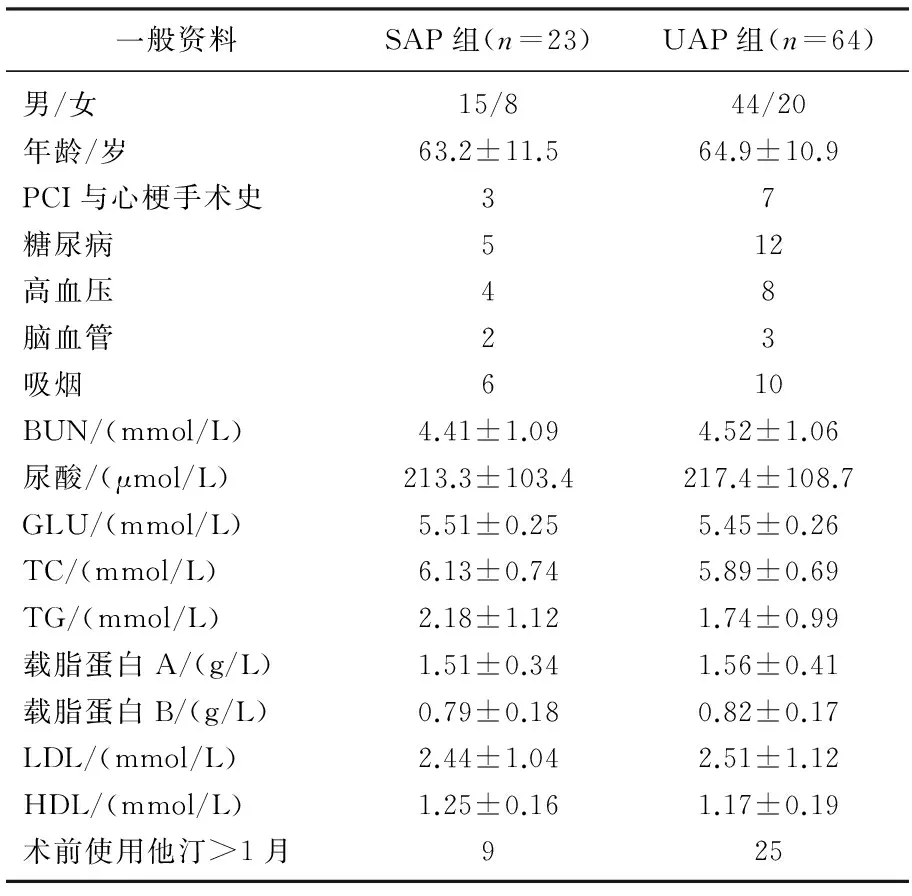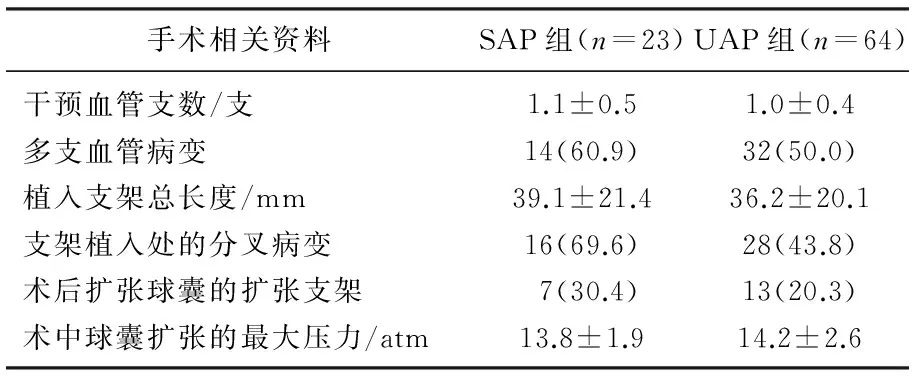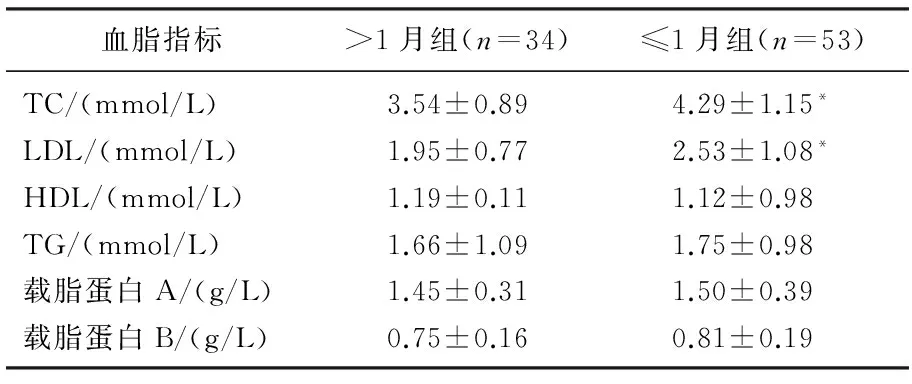冠心病患者PCI围术期心肌损伤的影响因素
任进平
(北京怀柔医院, 北京, 101400)
冠心病患者PCI围术期心肌损伤的影响因素
任进平
(北京怀柔医院, 北京, 101400)
目的 探讨行经皮冠脉介入治疗(PCI)术的冠心病患者围术期出现心肌受损现象的影响因素。方法 分析接受择期经皮冠脉介入治疗(PCI)治疗的87例冠心病患者的临床资料,其中稳定型心绞痛(SAP)患者23例,不稳定型心绞痛(UAP)患者64例。比较2组患者的一般临床资料、PCI术相关资料、PCI围术期出现心肌受损和心肌梗死的情况,采用多因素Logistic回归分析PCI围术期出现心肌受损的影响因素。比较入院时术前使用他汀>1月与≤1月患者的血脂水平。结果 2组患者的一般临床资料无显著差异(P>0.05)。SAP组的支架植入处的分叉病例比例显著高于UAP组(P<0.05)。2组患者PCI围术期出现心肌受损、心肌梗死的概率及术后的hs-CRP水平均无显著差异(P>0.05)。PCI围术期患者心肌受损的发生与载脂蛋白A、术前使用他汀1月以上、术前他汀负荷剂量治疗以及植入支架的总长度相关(P<0.05)。入院时术前使用他汀>1月患者的TC与LDL水平明显低于≤1月患者(P<0.05)。结论 载脂蛋白A的表达水平、PCI手术前采用负荷剂量的瑞舒伐他汀进行治疗以及术前应用他汀治疗1个月以上与PCI术围术期的心肌受损发生率的降低相关,冠脉内支架植入的总长度则与心肌受损发生率的上升相关。
经皮冠脉介入治疗; 瑞舒伐他汀; 载脂蛋白A; 围手术期心肌受损; 冠心病
经皮冠脉介入治疗术(PCI)能明显改善冠心病患者的预后及生活质量。研究[1-4]证实, PCI围术期的心肌受损与患者术后出现的不良事件相关。本研究对PCI围术期患者出现心肌受损的影响因素进行分析,现报告如下。
1 资料与方法
1.1 一般资料
分析2015年2月—2016年4月在本院接受择期经皮冠脉介入治疗(PCI)的87例冠心病患者的临床资料,其中稳定型心绞痛(SAP)患者23例,不稳定型心绞痛(UAP)患者64例。男59例,女28例,平均(64.2±10.9)岁。
1.2 研究方法
PCI术前用药情况: 所有受试者术前均给予300 mg氯吡格雷负荷剂量。手术前24 h内,随机给予瑞舒伐他汀负荷剂量(阿斯利康公司生产的10 mg/片瑞舒伐他汀, 20 mg), 或者不给予他汀负荷剂量,手术结束后每天继续口服10 mg的瑞舒伐他汀或者20 mg的阿托伐他汀。
收集资料: PCI术前对受试者的超敏肌钙蛋白I(Tropl)或超敏肌钙蛋白T(cTnT)、血常规、肝肾功能及血脂等进行测定,并记录患者以往的他汀服药史,即氟伐他汀不超过40 mg/d, 普伐他汀不超过20 mg/d, 辛伐他汀不超过20 mg/d, 阿托伐他汀不超过20 mg/d, 瑞舒伐他汀不超过10 mg/d。详细记录受试者的PCI及冠脉造影相关资料,以及支架植入处有无较大分支发出、应用后球囊是否扩张、球囊扩张的最大压力、PCI所有支架的总长度、冠状动脉病变的血管支数等资料。排除手术期间存在显著边支前向或边支闭塞心肌梗死溶栓实验(TIMI)血流比手术前降低1级以上,或者是支架植入的血管远端的TIMI血流比手术前降低1级以上的患者。
PCI手术第2天早晨空腹抽取受试者的静脉血,对血清中Tropl或cTnT及超敏C反应蛋白(hs-CRP)进行检测。手术结束后Tropl>0.08 μg/L或者cTnT>0.014 μg/L则认定为PCI围术期心肌受损; 手术结束后Tropl>0.40 μg/L或者cTnT>0.070 μg/L则认定为PCI围术期心肌梗死。
1.3 统计学方法
本研究中的数据均采用SPSS 19.0软件进行分析。数据计量以均数±标准差形式表示,比较采用t检验和卡方(χ2)检验。P<0.05为差异有统计学意义。
2 结 果
2.1 一般临床资料
本研究共纳入87例冠心病患者,其中SAP 23例, UAP 64例。2组患者的一般临床资料无显著差异(P>0.05)。见表1。

表1 2组患者的一般临床资料比较
2.2 PCI术的相关资料
87例冠心病患者均顺利完成了PCI术,且住院中并未出现与手术相关的死亡病例。SAP组的支架植入处的分叉病例比例显著高于UAP组(P<0.05), 而2组患者的其他PCI术的相关资料(包括干预血管支数、多支血管病变、植入支架总长度、术后扩张球囊的扩张支架以及术中球囊扩张的最大压力)并无显著差异(P>0.05)。见表2。

表2 2组患者PCI术的相关资料的比较
2.3 PCI围术期出现心肌受损和心肌梗死的情况
2组患者PCI围术期出现心肌受损、心肌梗死的概率及术后的hs-CRP水平均无显著差异(P>0.05)。见表3。

表3 2组患者心肌受损及心肌梗死发生率比较
2.4 PCI围术期引发心肌受损的影响因素分析
PCI围术期患者心肌受损的发生与载脂蛋白A、术前使用他汀1月以上、术前他汀负荷剂量治疗以及植入支架的总长度相关(P<0.05)。见表4。

表4 PCI围术期引发心肌受损的多因素Logistic回归分析结果
2.5 入院时术前使用他汀>1月与≤1月患者的血脂水平
入院时术前使用他汀>1月患者的TC与LDL水平显著低于≤1月患者(P<0.05), 而HDL、TG、载脂蛋白A及B水平并无显著差异(P>0.05)。见表5。

表5 入院时术前使用他汀>1月与≤1月患者血脂水平的比较
与>1月组比较, *P<0.05。
3 讨 论
经皮冠脉介入治疗(PCI)手术后10%~40%的患者的心肌坏死标志物水平会出现上升。2012年第3次全球心肌梗死新定义把PCI术后的心肌坏死标志物水平上升>99%正常参考值的上限认定为心肌受损,上升幅度为99%以上正常参考值的5倍认定为心肌梗死[5]。其机制可能是: 内皮受损,远端的微血管栓塞,支架释放或球囊扩张时血管暂时堵塞,冠状动脉出现痉挛现象,斑块异位致使边支闭塞,发生炎症反应以及缺血再灌注受损等现象。尽管此类心肌受损在部分患者身上并无显著症状,但是有些学者[6-7]认为其与PCI手术后出现的不良预后关系密切。
本研究多因素回归分析结果显示, PCI术前应用负荷剂量的瑞舒伐他汀是独立影响PCI围术期心肌受损发生率下降的重要因素。由于应用负荷剂量瑞舒伐他汀的患者只是PCI手术前增加了一次剂量,短时间内低密度脂蛋白(LDL)下降和高密度脂蛋白(HDL)上升的效应并不显著[8],故考虑他汀类药物特有的多效性与其使PCI围术期心肌受损发生率下降的机制相关[9]。
本研究结果显示,术前应用他汀类药物进行治疗时间1个月以上与术前呈高表达状的载脂蛋白A均是对PCI术围术期出现心肌受损现象构成负影响的重要因素,同时作者还发现此类患者的总胆固醇(TC)和LDL水平均较低,考虑术前长期应用他汀类药物治疗使围术期心肌受损发生率降低的机制与其持续使LDL水平降低可能相关。他汀长时程的治疗可以对羟甲基戊二酸单酰辅酶A(HMG-GoA)还原酶抑制剂的水平起持续抑制的作用,进一步使动脉粥样斑块稳定,减少PCI手术期间由于机械受损导致斑块破裂引发远端血管栓塞的风险,从而达到降低PCI围术期出现心肌受损现象的概率。
载脂蛋白A在人体脂质代谢中也扮演了重要角色,其是HDL的功能蛋白与主要结构,在胆固醇的逆转运过程中也发挥了一定的作用,同时通过从LDL中移除氢过氧化二十碳四烯酸和过氧化十二碳二烯酸,确保LDL不受动脉壁细胞所氧化,充分发挥其抗氧化的重要作用。此外,载脂蛋白A还具有预防冠状动脉内血栓形成和抗炎的作用[10]。故高表达状的载脂蛋白A是降低心肌受损发生率的一个可能机制,但其确切机制还需更深入的研究证实。
冠脉内支架的植入总长度较长与心肌受损发生率呈正相关,此与行PCI术的冠心病患者有较长的冠状动脉病变需要干预,斑块及血管内皮受损比较广泛,导致大量斑块碎屑将远端微血管堵塞,从而引发了冠脉影像学中较难被发现的心肌受损现象可能相关,故冠脉内支架植入的总长度过长可能会增加围术期心肌受损的发生风险,同时据报道[11], 冠脉内支架植入的总长度过长与不良预后以及冠脉内血栓的形成密切相关。
[1] Tantry U S, Bonello L, Aradi D, et al. Consensus and update on the definition of on-treatment platelet reactivity to adenosine diphosphate associated with ischemia and bleeding[J]. J Am Coll Cardiol, 2013, 62(24): 2261-73.
[2] Harmsze A M, van Werkum J W, Souverein P C, et al. Combined influence of proton-pump inhibitors, calcium-channel blockers and CYP2C19*2 on on-treatment platelet reactivity and on the occurrence of atherothrombotic events after percutaneous coronary intervention[J]. J Thromb Haemost, 2011, 9(10): 1892-901.
[3] Graham M M, Ghali W A, Southern D A, et al. Outcomes of after-hours versus regular working hours primary percutaneous coronary intervention for acute myocardial infarction[J]. BMJ Qual Saf, 2011, 20(1): 60-7.
[4] Gerbaud E, Faury A, Coste P, et al. Comparative analysis of cardiac magnetic resonance viability indexes to predict functional recovery after successful percutaneous coronary intervention in acute myocardial infarction[J]. Am J Cardiol, 2010, 105(5): 598-604.
[5] Pullara A, D′Ascenzo F, Gonella A, et al. Very long-term outcome of peripheral arterial disease in patients undergoing percutaneous coronary revascularization: a retrospective analysis[J]. Minerva Cardioangiol, 2012, 60(6): 553-60.
[6] Trompet S, Pons D, Kanse S M, et al. Factor VII Activating Protease Polymorphism (G534E) Is Associated with Increased Risk for Stroke and Mortality[J]. Stroke Res Treat, 2011, 2011: 424759.
[7] Guo S Z, Wang N F, Zhou L, et al. Influence of granulocyte colony-stimulating factor on cardiac function in patients with acute myocardial infarction and leukopenia after revascularization[J]. Chin Med J (Engl), 2010, 123(14): 1827-32.
[8] Lu J Q, He G X, Pan C X, et al. Effect of anxin granules combined with tirofiba on patients with acute myocardial infarction after elective percutaneous coronary intervention[J]. Zhongguo Zhong Yao Za Zhi, 2014, 39(5): 920-4.
[9] Hedegaard A, Ripa R S, Johansen J S, et al. Plasma YKL-40 and recovery of left ventricular function after acute myocardial infarction[J]. Scand J Clin Lab Invest, 2010, 70(2): 80-6.
[10] Pain T E, Jones D A, Rathod K S, et al. Influence of female sex on long-term mortality after acute coronary syndromes treated by percutaneous coronary intervention: a cohort study of 7304 patients[J]. Coron Artery Dis, 2013, 24(3): 183-90.
[11] Sambu N, Warner T, Curzen N. Clopidogrel withdrawal: is there a "rebound" phenomenon[J]. Thromb Haemost, 2011, 105(2): 211-20.
Influencing factors of perioperative myocardial injury in coronary heart disease patients with PCI
REN Jinping
(Beijing Huairou Hospital, Beijing, 101400)
Objective To explore the influencing factors of perioperative myocardial injury in coronary heart disease patients with PCI. Methods Clinical materials of 87 coronary heart disease patients with PCI were retrospectively analyzed, including 23 stable angina pectoris patients (SAP) and 64 unstable angina pectoris patients (SAP). The general information, PCI operation related data, the perioperative myocardial injury and myocardial infarction were compared between two groups. The influencing factors of perioperative myocardial injury in coronary heart disease patients with PCI were analyzed by Logistic regression. The level of blood fat was compared between patients with administration of rosuvastatin >1 month and ≤ 1 month. Results There was no significant difference of general information between two groups (P>0.05). In the SAP group, the number of SAP patients with stent implantation was significantly higher than that of UAP group (P<0.05). There was no significant difference between the two groups in myocardial injury, myocardial infarction, and the level of hs-CRP after PCI (P>0.05). The incidence of myocardial damage in patients with PCI during perioperative period was associated with apolipoprotein A, preoperative statin use, preoperative statin dose therapy, and total length of the stent (P<0.05). At the time of on admission and preoperative, TC and LDL levels of patients with use of statins over one month before operation on admission was significantly lower than patients with use of statins less than one month (P<0.05). Conclusion The loading of apolipoprotein A expression, use of rosuvastatin before PCI, use of statin over 1 month are closely related with the decrease of myocardial injury rate in perioperative period of PCI, and the total length of intra-coronary stent implantation is associated with increasing incidence of myocardial damage.
percutaneous coronary intervention; rosuvastatin; apolipoprotein A; perioperative myocardial damage; coronary heart disease
2016-12-20
北京市科技局基金项目(20150425)
R 541.4
A
1672-2353(2017)11-005-03
10.7619/jcmp.201711002

